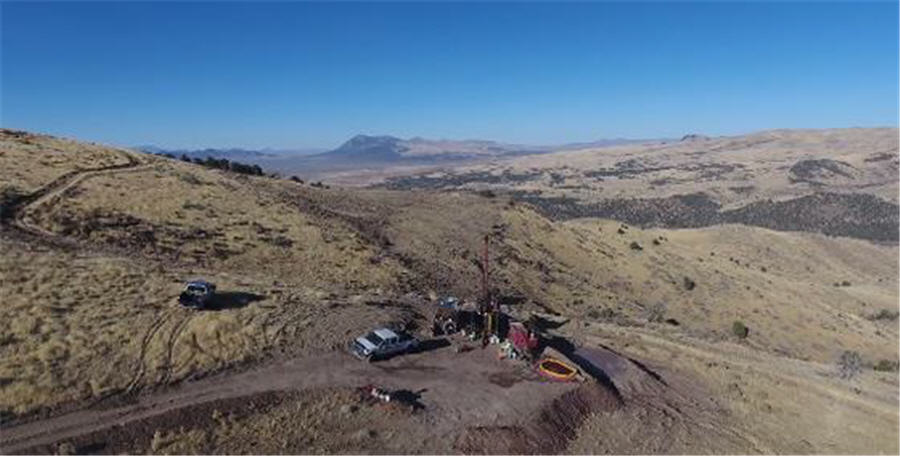
Current Price: $2.26
Shares Outstanding: 12.4 million
Market Capitalization: $28.0 million
Cash: $4 million
Rain Man is not a self-given nickname.
Dave Mathewson is synonymous with gold exploration in Nevada, and the nickname was given due to his multi-million-ounce discoveries in and around the Rain District.
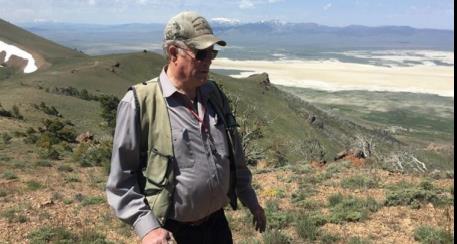
(Dave Mathewson, Source: Corporate Presentation)
He spent the last 35 years of his career in Nevada. He was the Head of Newmont Nevada’s Exploration team from 1989 to 2001, where he made the discoveries of Tess, Northwest Rain, Saddle and South Emigrant in the Rain mining district. Dave and his team were also responsible for the deposit extension discoveries at Newmont’s Gold Quarry and Mike deposits.
After Newmont, Dave Mathewson founded Tone Resources, which was acquired by McEwen Mining in 2007 during an aggressive roll-up of the area.
Gold investors are likely more familiar with his work at Gold Standard Ventures (CVE:GSV), a company he co-founded in 2009. Dave’s team consolidated the Railroad-Pinion district and discovered the North Bullion, Sylvania, and Bald Mountain deposits. Gold Standard Ventures was one of the sweet heart deals of the new resource cycle. Since its inception, the company rose in value from C$26 million to a high of $835 million.
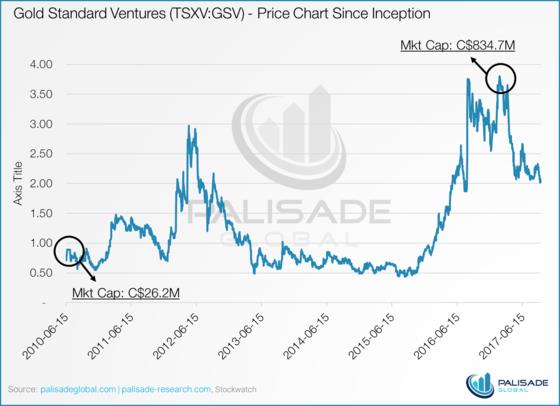
It is obvious the theme for this cycle is brand new discoveries. Major gold producers are sinking their teeth into exploration companies with highly prospective, district size land plays for the next new deposit.
Oceanagold (TSX:OGC) has invested $30.1 million, and Goldcorp (TSXV:G) has invested $16.1 million into Gold Standard. The two producers own 9.9% and 15.8%, respectively.
Goldcorp has been very active in the exploration-front, stating earlier this year it was looking to invest at least $100 million in junior explorers that have early stage projects with district-scale potential. The company, like other senior producers, are after the new districts that can yield 5 to 10 million ounces of gold, and that will deliver up to 500,000 ounces in annual production.
Goldcorp has seen this potential in Auryn Resources (TSX: AUG), investing $35 million into the explorer for its flagship Committee Bay gold project in Nunavut. Also, the producer has been very active in the Yukon, acquiring Kaminak Gold for $520 million for its 5.2-million-ounce Coffee gold project. And more recently investing $4.8 million into Triumph Gold, for its high-potential Free Mountain project, already home to 3.3 million ounces of gold with limited exploration.
Dave Mathewson – “Keystone Is Like Gold Standard’s Railroad… But On Steroids”
The Keystone project has been on Dave’s radar since 1984, when he was working for Atlas Precious Metals Inc., who at the time operated the Gold Bar Mine. Keystone was owned by Placer Dome at the time, but Dave kept it in the back of his mind. As his career progressed, he began staking areas whenever he could, slowly consolidating the area.
The last of the puzzle became available when McEwen Mining decided to drop the integral Eastern Plank, and Dave finally had his unicorn.
He took the project to Gold Standard Ventures, who opted to pass on it to concentrate on proving up its 208 km2 Railroad-Pinion project.
Being an exploration geologist to the core, James simply quit and called Ed Karr, a financier who Dave met as in investor into GSV.
Ed, the President and CEO of US Gold, is the founder of several investment banking firms in Geneva, Switzerland, and has been active in the natural resource industry for years. He was also a Founder and currently serves on the Board of Directors of Pershing Gold Corp.
Circumstance had it, Ed held a private mining company, US Gold, that he founded in February 2014 to acquire the advanced-stage copper and gold project, Copper King, located in Wyoming. Ed and his investors bought Copper King from Energy Fuels, who had acquired it when it bought out Strathmore Minerals for its uranium resources.
Despite Copper King having a PEA that demonstrates strong economics, the project was shelved. Ed approached CEO, Stephen Antony in 2014, and a JV was formed. Since then, US Gold has bought the project outright for a total of US$3 million. The plan was to hold it until the markets turned and sell it for a tidy profit.
The plan changed when Dave called Ed, and touted Keystone as the best exploration project in his career. Ed didn’t need too much convincing, and acquired Keystone for a combination of cash and enough stock to make Dave the largest shareholder. US Gold now has an advanced stage project to embed true value, and significant blue-sky potential in its exploration assets.
When Luke Norman, a co-founder of Gold Standard Ventures heard of the new venture, he jumped ship and joined US Gold in a corporate development capacity. Luke has raised over $300 million in his career, honing his skills in the venture capital markets for almost 20 years. A lot of GSV’s success hinged on the fact it had the cash to actually explore.
The exodus also included Neil Whitmer, who served as the Manager of Land, Legal, and Environmental Affairs at Gold Standard. A geologist and lawyer, he joined US Gold as the Operations Manager, where he advises on operational and regulatory matters relating to acquisition, due diligence, title review, permitting, and maintenance of mineral and surface rights.
With significant assets and a proven team in place, Ed was able to raise $4 million privately, and another $12 million via New York-based investment banks. In June 2016, NASDAQ-listed Dataram acquired US Gold in a reverse take-over, and subsequently changed its name and ticker.
A Deeper Look Into The Assets
Keystone & Gold Bar North (GBN)
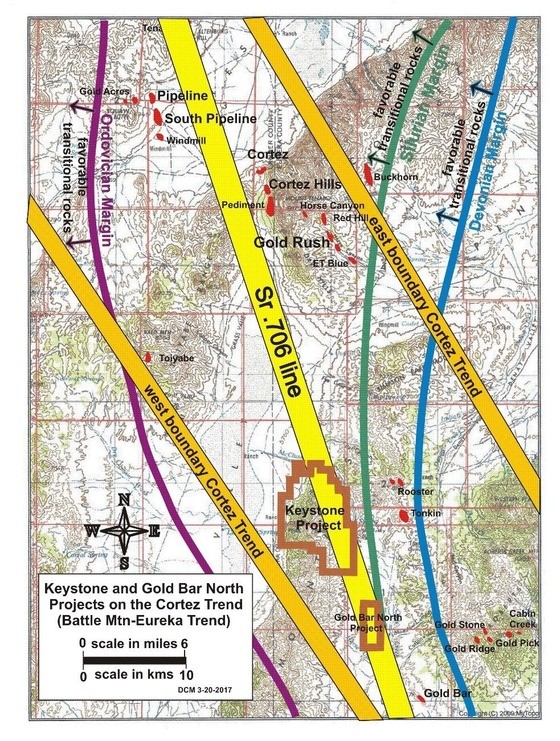
(US Gold Property Map, Source: Corporate Website)
Keystone is located in north-central Nevada, just 10 miles south of Barrick’s Cortez Hills and Pipeline, where a total of 1.06 million ounces of gold was produced in 2016 at in all-in sustaining cost of $517 per ounce. The two projects currently host 10.2 million ounces of reserves averaging a grade of 2.11 g/t.
Also in the vicinity is Barrick’s Goldrush, currently in development. Barrick has completed a PFS for an underground mine, where plans estimate average annual production of 440,000 ounces for the first five years at all-in sustaining costs of $665 per ounce. The project contains 11.5 million of gold resources at an average grade of 9.34 g/t.
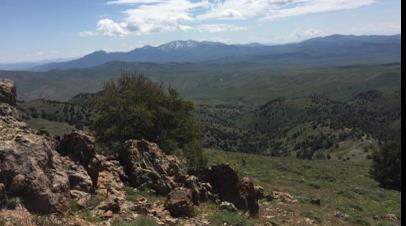
(Rocks at Keystone, Source: Corporate Presentation)
Dave sees many similarities between Cortez Hills and Keystone in the geology. In fact, US Gold’s Senior Consulting Geologist, spent the last 14 years of his career as the Senior Geologist at the Cortez Gold Mine and knows the area like the back of his hand. He says Keystone is identical.
Dave first used scout drilling at Keystone to make sure the rocks were correct. The six-holes confirmed host rocks that included Devonian Horse Canyon and Wenban limestone formations, the same rocks at the Pipeline, Cortez, Cortez Hills, Red Hill, and Goldrush deposits to the north. While not ‘market’ holes, the program puts US Gold on the precipice of a major discovery.
The company recently completed a 9-hole program, headlined by hole Key17-1c, a core hole drilled to 490 meters, encountering over 300 meters of host rock and mineralization of up to 1 g/t. US Gold has now drilled into the ballpark, and is well on its way to finding home base.
Dave plans on following up the drilling with a modest 4-5-hole program in the fall. The company is working on an EA plan, so that in early-2018 it will have carte blanche with a more extensive program.
Gold Bar North was recently acquired from Dave in June 2017. Regional data shows a clear linear gravity and magnetic connection of Gold Bar North to both Keystone and Gold Bar gold deposit to the south. The Gold Bar deposit, (not to be confused with Gold Bar North), is a 722,000 ounce (0.96 g/t), FS stage project owned by McEwen Mining. Average annual production is slated for 65,000 ounces at a cash cost of $728 per ounce.
GBN’s host rocks correlate with the same permissive calcareous-siltstone Devonian Horse Canyon and limestone Wenban Formations at Keystone. This year GBN will undergo further permitting, mapping, and geophysics.
Copper King
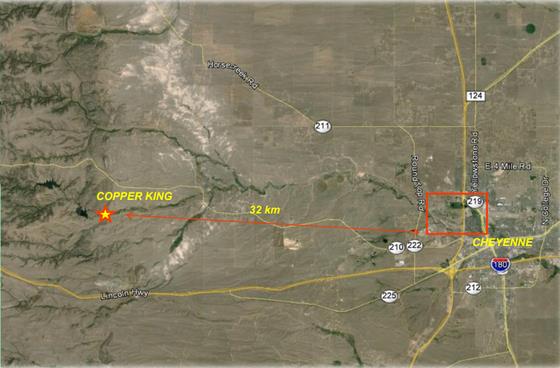
(Location of Copper King, Source: Corporate Presentation)
Copper King provides real tangible value to US Gold, and is definitely not on the backburner to the Nevada assets. The company has assembled a team to expand upon the current gold and copper resource, while advancing the project into production.
The current PEA estimates an NPV5 of $159.5 million, utilizing a gold price $1,100/oz. and a copper price $3.00/lb. US Gold plans on updating the PEA to reflect the current market, and continue exploration and development, including deposit delineation, resource expansion, environmental studies, metallurgical test work, and mine plan development.
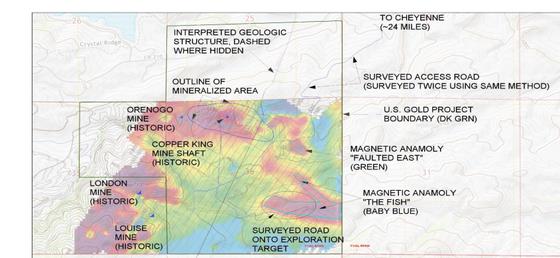
At its current resource, the Copper King does not register on any producer’s radar. However, the Fish/Baby Blue target has the potential to more than double the current resource. It is a second potential deposit that has never been drilled. The company plans on tightening up the target with an IP survey in the fall, and drilling as early as November.
Can US Gold Be The Next Gold Standard Ventures?
It certainly looks like it. The company has the right projects and people to make it happen.
We enjoy the fact that the company has a base valuation in the Copper King, but also significant exploration upside in Keystone and Gold Bar North.
And at a market cap of $28.0 million, the market obviously has not caught wind of the story.
There are many exciting catalysts on the horizon, the largest being the coming drilling at Keystone. The company is at the cusp of a major discovery, and current prices provide an opportune entry.
Palisade Global Invest ments Limited holds shares of US Gold Corp. We receive either monetary or secu rities compensation for our services. We stand to benefit from any volume this write-up may generate. The information contained in such write-ups is not intended as individual invest ment advice and is not designed to meet your personal finan cial situation. Information contained in this report is obtained from sources we believe to be reliable, but its accuracy cannot be guaranteed. The opinions expressed in this report are those of Palisade Global Invest ments and are subject to change without notice. The information in this report may become outdated and there is no obligation to update any such information. Do your own due diligence.